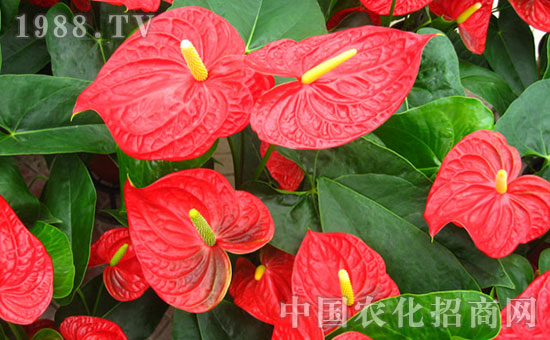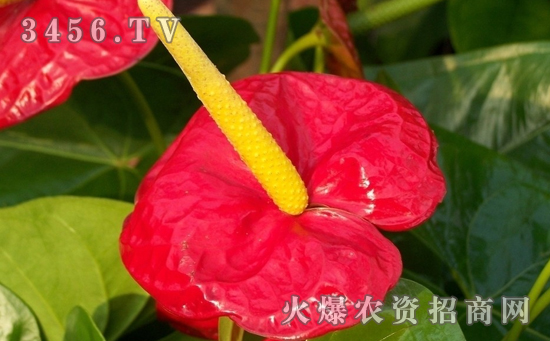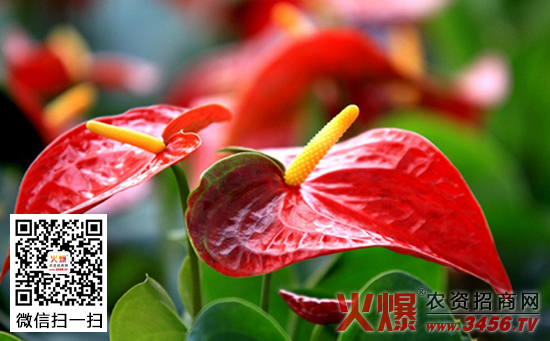Prevention and control of diseases and insect pests of Anthurium andraeanum flowers, how to remedy aphids and how to treat aphids when the leaves of Anthurium andraeanum turn yellow
Anthracnose and root rot are common diseases of Anthurium andraeanum. Anthracnose harms twigs and leaves, and the infected parts first appear watery spots, which are round or nearly round, showing dark brown. Subsequently, the plaque continues to expand, there are wheel lines, the central part becomes light brown or gray, there are many small black spots above, and the edges are purplish brown or dark brown.
Root rot harms roots. After the plant was infected, the lower leaves withered first. After pulling out the diseased plant, you will find that some of the roots appear flooded, turn brown or black, and rot. For the diseases of Anthurium andraeanum, we should adhere to the principle of "giving priority to prevention and comprehensive management", and focus on the following work:
(1) do a good job in environmental hygiene and pull out weeds. Thoroughly disinfect the hot and hot facilities in the greenhouse before planting, remove and burn fallen leaves, diseased leaves, rotten roots and diseased plants in time, so as to reduce the spread of diseases.
(2) choose more disease-resistant varieties. Strengthen the management of temperature, humidity, light intensity and fertilizer and water, cultivate robust plants and enhance disease resistance.
(3) after the occurrence of root rot, it can be irrigated with 1500-2000 times of 25% Ruidoxime wettable powder; for anthracnose, it can be prevented and treated with 50% methyl thiophanate wettable powder and 75% chlorothalonil wettable powder.
The common pests of Anthurium andraeanum are aphids, whitefly and so on. The yellowing of pests can be used to trap and kill, the specific method is: take a transparent plastic, the size is 10 cm × 25 cm, first apply yellow pigment, the best color is marigold yellow, and then apply a layer of No. 10 engine oil. Put the plastic at the height of 30 cm ~ 50 cm above the plant, and the quantity is 34 yuan per mu.
Pest control of Anthurium andraeanum
The prevention and control of Anthurium andraeanum diseases and insect pests must adhere to the principle of "prevention first, comprehensive management".
First, do a good job in environmental hygiene, and check regularly to form a system
1. Root out host plants and pull out harmful weeds.
2. Thoroughly disinfect greenhouse facilities and media before planting.
3. Remove and burn deciduous leaves, diseased leaves, rotten roots and diseased plants in time.
4. Provide visitors with sterilized soap or 75% alcohol and wash their hands.
Second, put agricultural prevention and control in the first place
1. Strict quarantine and selection of disease-resistant and insect-resistant varieties for tissue culture seedlings.
2. Strengthen the management of temperature, humidity, light intensity and fertilizer and water, cultivate strong plants and enhance the ability of resistance to diseases and insect pests.
3. Knives and scissors should be used separately. Prepare a few more, use alternately, soak in 75% alcohol for 3 minutes before use and disinfect.
4. Catch insects artificially, remove the leaves of diseases and insects, and scrape off shell insects.
5. Improve the ventilation and light transmission conditions by pruning (protecting the wound), so as to make Anthurium grow strong.
6. Keep the plant dry as much as possible to prevent water splashing.
7. The operating procedures are strictly sequenced, and the most hygienic ones should be done first.
III. Biological control
1. Protect natural enemies and forbid hunting and killing beneficial birds, frogs, toads and so on.
2. Use beneficial bacteria, fungi and viruses to control insects.
IV. Physical prevention and control
1. Use black light to trap pests and poison them.
2. Some pests were induced by yellow viscose board.
5. Use botanical agents
VI. Chemical control
What are the prevention and control methods of common diseases and insect pests of Anthurium andraeanum?
Anthurium andraeanum is also often called candle, and its flower language is to show great ambition and enthusiasm. The common colors of Anthurium andraeanum are red, pink, white and so on, which have great ornamental value. During the planting period of Anthurium andraeanum, there are many diseases and insect pests that will endanger its health, so we should control them in time. Next, the editor will introduce to you the harm and control methods of common diseases of Anthurium andraeanum.

Anthurium anthurium aphid
Symptoms:
The aphids themselves are light green, yellow or pink, with six legs and about 2mm. The aphid population develops rapidly because it is viviparous and divides into honey, which leads to the growth of fungi. Aphids will cause spots on flowers and leaves, thus reducing the quality of the commodity, and will also absorb plant juice, and then inject poison into plant tissue to affect plant growth. Aphids have many plant hosts, resulting in the rapid spread of diseases.
Prevention and control methods:
Spray any of the following agents, and then spray five days later: aldicarb, heptene phosphorus, bifenthrin, high efficiency (imidacloprid). Or use natural enemies to prevent and control.
Rhizoctonia
Symptoms:
The base or root of the plant is brown or brown.
Prevention and control measures:
a. Soil disinfection, 5 grams of carbendazim mixed with 25 kilograms of planting substrate.
b. At the initial stage of the disease, 20% methyl rifampicin EC was sprayed with 1200 times solution, or 72.2% Prik 800 times solution was sprayed.
These are the prevention and control methods of some common diseases and insect pests of Anthurium andraeanum. This knowledge will help you to plant your Anthurium andraeanum and make your Anthurium grow better.
Extended reading:
How to raise Anthurium andraeanum? Cultivation methods, fertilization techniques, disease control and flower language of Anthurium andraeanum
What if the leaves of Anthurium andraeanum turn yellow?
1. Reason: if there is a problem with yellow leaves in soil-cultivated Anthurium andraeanum, it is most likely due to too much watering, causing damage to its roots. Secondly, it may be because the flower soil has been hardened, or the alkalinity is too strong, so that it has discomfort.
2. Treatment: first turn over the flower soil, and then take it out of the soil. Then take a look at the state of its roots to see if there are any rotten roots. If so, it needs to be cut off immediately. After dealing with it, prepare some new flower soil with good permeability and plant it into it.
- Prev

How to prevent anthracnose of Anthurium andraeanum?
The disease is caused by a semi-known fungal fungus of Colletotrichum. The pathogen survived the winter in the diseased tissue or basin with mycelium and conidia, carried out primary infection and re-infection with conidia, and spread by Rain Water sputtering and small insect activity. Usually warm and humid weather and ecological environment can easily cause the disease.
- Next

What about the rotten roots of Anthurium andraeanum?
[symptoms] at the initial stage, a small number of roots were infected, yellowish to brown stripes appeared on the root surface, and the cortex gradually swollen and rotted. With the continuous reproduction of nematodes in the roots, the whole root system was infected, and the root system shrunk, turned brown, and finally rotted black. There are no obvious symptoms in the upper part of the plant with mild disease.
Related
- Fuxing push coffee new agricultural production and marketing class: lack of small-scale processing plants
- Jujube rice field leisure farm deep ploughing Yilan for five years to create a space for organic food and play
- Nongyu Farm-A trial of organic papaya for brave women with advanced technology
- Four points for attention in the prevention and control of diseases and insect pests of edible fungi
- How to add nutrient solution to Edible Fungi
- Is there any good way to control edible fungus mites?
- Open Inoculation Technology of Edible Fungi
- Is there any clever way to use fertilizer for edible fungus in winter?
- What agents are used to kill the pathogens of edible fungi in the mushroom shed?
- Rapid drying of Edible Fungi

